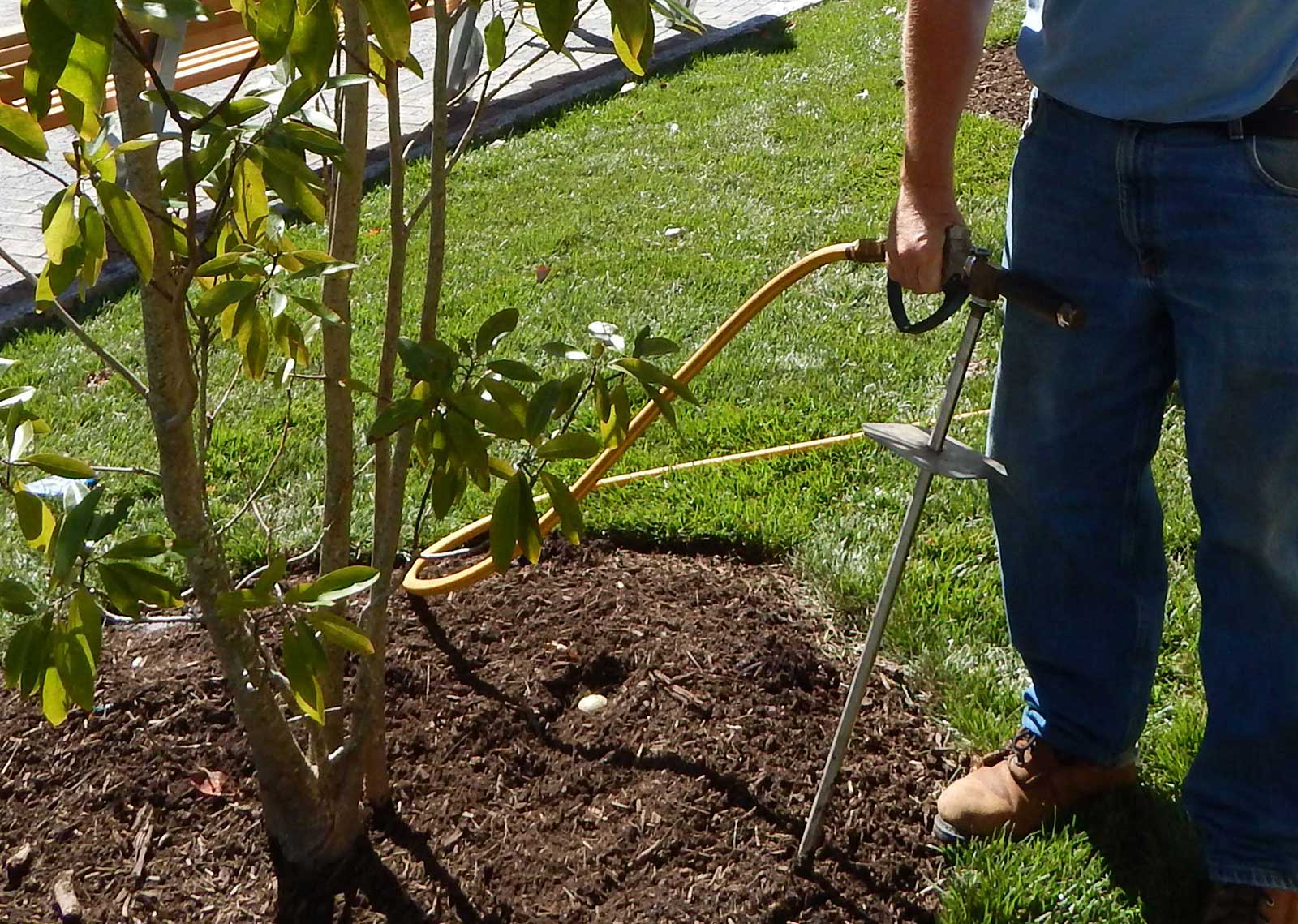Deep Root Feed | Tree Fertilization
Sustainable Landscaping with Organics
Do My Trees Need Fertilized?
Notice discoloration within your tree’s foliage and leaves? Maybe it doesn’t seem to be growing as much as it did the past two or three years? With some visual inspection, trees can provide some signals that things aren’t as they should be. Some signals that a tree exhibits when under strees and in need of fertilization include:
Smaller Leaves – It may be hard to notice, but if the leaves grow smaller with each passing year, that’s often a sign that the nutrients in the soil are being used up. If you have the opportunity to compare leaf sizes, this may be a good way to tell that your tree needs nutrition.
Yellow Leaves – In fall, leaves tend to turn yellow. But in spring and summer, the leaves are almost always supposed to be green. If you have yellow leaves early, before they traditionally occur, you may have a nutrition problem and your tree may be in need of fertilizing.
Trouble Growing – Every year, trees should grow. Trees on average should grow at least 6″ in height. Their branches should expand, they should get leaves – they should even get ever so slightly thicker. If this doesn’t occur, it is possible that your trees simply do not have the nutrition they need to continue growing.
Tree roots need a healthy soil, the proper balance of nutrients, and air (or oxygen) in the soil to stay healthy. Our deep root tree fertilization is a service we provide wherein a high quality, custom blended, nutrient solution (compost tea based) is injected into the root zone of trees. These materials are injected under pressure which helps aerate the soil and provide much needed oxygen for the root system. The solution encourages microbial activity to enrich the soil and increases the nutrient levels, providing for a healthier and longer lived tree.
 Soil injection sites are placed approximately two to three feet apart in a grid pattern within the understory of the tree canopy area and beyond, in some cases. Deep root feeding injects our custom-formulated, organic mixture as a liquid suspension into the top six to twelve inches of soil where the majority of a tree’s fine feeder root system develops.
Soil injection sites are placed approximately two to three feet apart in a grid pattern within the understory of the tree canopy area and beyond, in some cases. Deep root feeding injects our custom-formulated, organic mixture as a liquid suspension into the top six to twelve inches of soil where the majority of a tree’s fine feeder root system develops.
The material is injected into the root zone at approximately 40 psi, or pounds of pressure per square inch. The fertilizer injection process also aerates, or adds oxygen, to the critical soil area around your tree where it is most beneficial. The pressure also acts to open the pore spaces in the soil, allowing additional air to more easily enter the soil profile, especially in the top six to twelve inches of soil. The oxygen begins its journey into the tree’s vascular system as if the root system was the tree’s lungs. This oxygen is extremely beneficial in a multitude of chemical reactions and processes your tree carries out every second of every day.
One of the most prevalent components of our fertilizer mix is humates. Humates provide a multitude of benefits to both the soil and the tree. Think of them as high-quality compost or organic matter. Humates, in a native forest, are the materials supplied by the decomposing leaves in a nutrient-rich forest floor. Humates are now recognized as the single most productive input in sustainable agriculture. They consist of humic and fulvic acid along with the raw humates (prehistoric plant matter) from which these powerful natural acids are derived. Humic acid is a powerful fungi promotant. Beneficial fungi (including mycorrhizal fungi) are the missing link in many soils. It stabilizes nitrogen and improves nitrogen efficiency.
A few of the many benefits of humates are as follows:
1 – Humates increase the absorption efficiency of plant nutrients which reduces the need to continuously add synthetic nitrogen and phosphorous to your soil for root growth.
2 – Humates increase soil aeration; i.e., increases the oxygen content of your soil.
 3 – Humates promote a greener leaf color and increase the density of foliage.
3 – Humates promote a greener leaf color and increase the density of foliage.
4 – Humates promote root respiration and absorption of oxygen.
5 – Humates promote better drainage in heavy clay soils.
6 – Humates have additional growth-promoting compounds.
Tree and plants like a fungal dominated tea. Within the soil the mycorrhizal fungi establishes a symbiotic relationship with plant roots by penetrating plant root tissues and surrounding root mass to more effectively take in needed nutrients.
Our fertilizer mixture is not a complex mystery of magical goodies of which we hold the secret formula. It is a fertilizer consisting of tried and true organic properties proven to be effective by top arborists around the world, as being the most important organic materials for healthy root growth for all plants and trees. Deep Root Tree Feeding – It’s the fastest way to get nutrients to the tree and has the added benefit of aerating the soil.
At Lincoln Landscaping cultivating the environment is our life and livelihood. It is our number one goal to help our clients create and maintain beautiful landscapes while reducing the impact on the environment. Whether you are interested in a pollinator landscape garden design and build or other landscaping or property management project; we can create for you an environmentally friendly, organic and beautiful property.
Together with you, we create sustainable Eco-Systems. As the Navajo Indians would say “Yua Tah Hey”
Lincoln Landscaping “The Natural Choice”
Mike Kolenut President & CEO
https://lincolnlandscapinginc.com
(201) 848-9699



